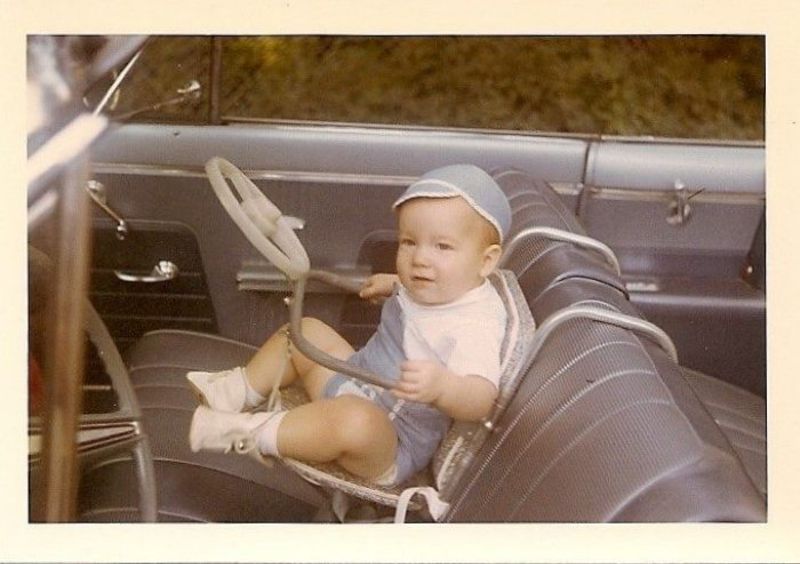A Look Back: The History of Car Seats
We at WAYB knew we were disrupting the car seat industry in a big way when we introduced the Pico Car Seat. With its AeroWing™ space-grade aluminum frame, compact fold, and ultralight design (just 8 lbs!), Pico has been a game changer from the start.
Here's a look back at how far the child passenger safety world has come since the advent of the first car seat through today.
1920s - 1930s
The first children’s car seats were created. The focus of these early seats was keeping kids still, rather than safety. Some of these early iterations were made of metal with faux leather straps (see image courtesy of henryford.org) and others resembled burlap sacks with two holes cut in them for little legs and dangled off of the headrest.

1940s
Booster chairs were made available so kids could see out the window in the car. Great for playing the classic road trip game “I Spy” -- but again, not so great for safety.

Early 1960s
The first car seats were created that took advantage of seat belts for a more secure restraint.
Late 1960s
Ford Motor Company’s Tot-Guard hit the market. It was basically a plastic tunnel shaped like a seated child with a hole for their legs to pop out of and a pillow (yes, a pillow) strapped to the front. Presumably, in the event of a fender bender, the child would go forward, hit the pillow, and be… safer than if they were seated in a burlap sack.

Check out this blurb on the Tot-Guard from an issue of Time Magazine published on October 13, 1967:
“Seat belts may be all right for adults, but try keeping a squirming five-year-old child buckled up for a long automobile ride. It cannot be done, short of resorting to chloroform. Last week the Ford Motor Co. showed off its answer: a 5-lb. padded plastic body shield called the 'Tot Guard.' The child sits on a molded seat; then a loosely fitting, one-piece leg-and-body 'cast' is placed over him. The seat belt loops around in front to secure the entire apparatus, allowing the child to move around inside his cast but also to stay in one place.” - Time Magazine, October 13, 1967
Around this same time, the Love Seat, made by General Motors, came onto the car seat scene. This was the first design to cater to children and infants individually for their different needs. Made from polypropylene and padded with urethane foam, it was touted as lightweight and portable.
The Steel Travel Platform was also introduced in the 1960s. It was a vinyl-covered foam pad for kids to sleep or play on in the backseat of a car. Again, safety was still not top of mind for many kid-in-car products.
Here's a page from the 1969 Sears catalog that gives a good sense of where we were in terms of safety standards.

1970s
In 1971, the very first standard was set by the National Highway Traffic Safety Administration (NHTSA). It required all seats to be installed using safety belts and to include a 3-point harness to restrain the child in the seat. But no crash testing was yet required.
1980s
By 1985, the first child passenger safety laws were passed. They required children under a certain age to ride in a car seat when traveling in a passenger vehicle.
2000s
LATCH systems were required law to improve the stability of car seats in the event of an accident. The 2000s saw tremendous progress in child passenger safety products and technology, from infant car seats, to convertible seats, to boosters.
2019
The WAYB Pico Car Seat is born! WAYB was founded to champion family travel, and to make it easier. We wanted to help parents get out in the world, without compromising on beautiful design or sustainable materials. That’s why we came up with the Pico Car Seat.

The idea first came about when we noticed parents struggling to lug bulky car seats through the airport. By using innovative design and aerospace-grade aluminum, we created a super strong, ultralight travel seat that makes traveling with kids a breeze.
And, of course, the Pico meets all U.S. standards regulated by the National Highway Traffic Safety Administration (NHTSA) and by the Federal Aviation Administration (FAA). The Pico has been tested to meet all standards listed in FMVSS 213. You can read more about WAYB and our Safety Standards here.
About the author: Sawyer Perry is the Happy Traveler Manager at WAYB and a certified Child Passenger Safety Technician (CPST).
References and sources:
10 Baby Gear: History of Baby Car Seats
Popular Science: From Deathtrap to Lifesaver: The Evolution of the Car Seat
